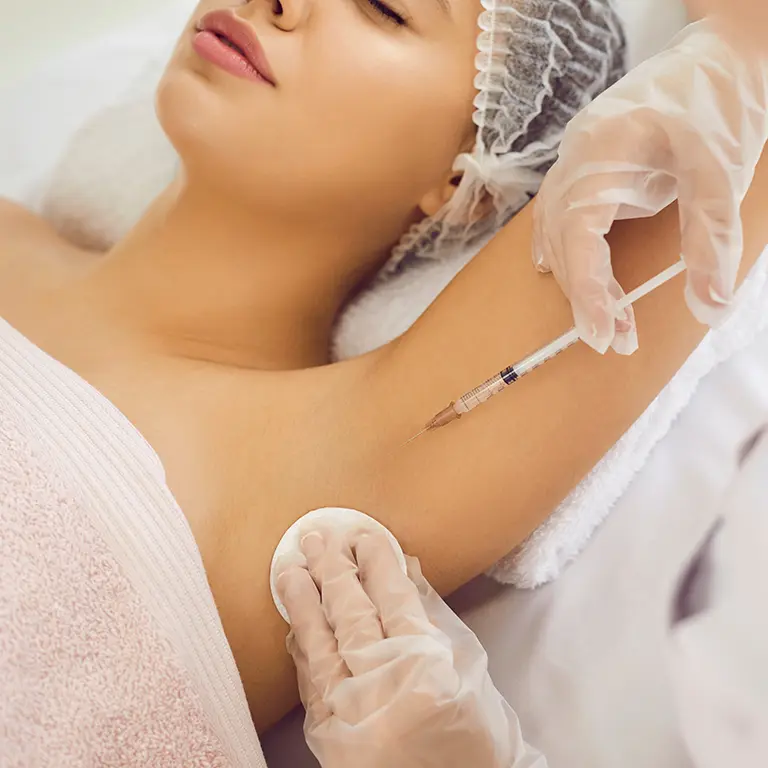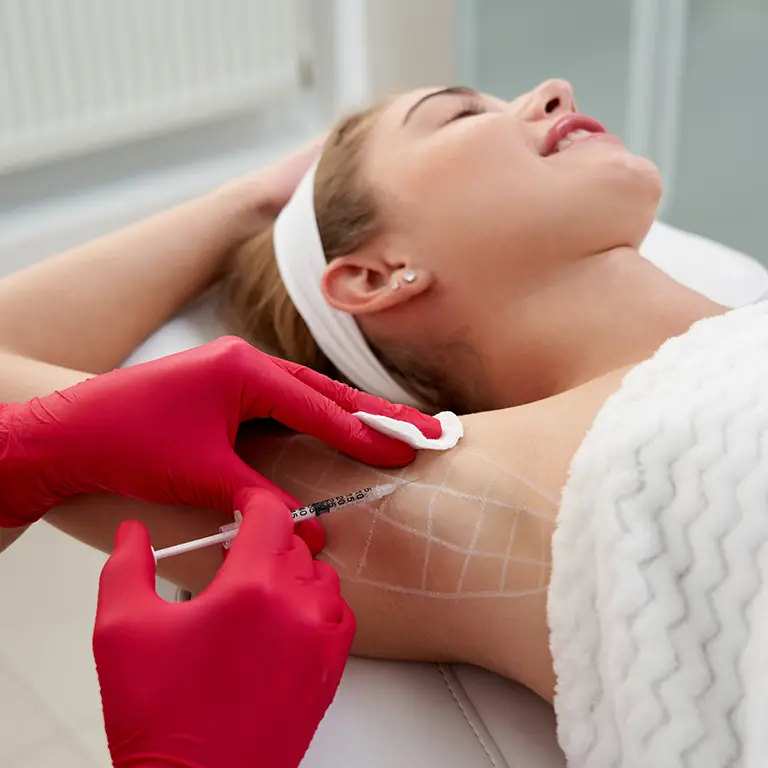Hyperhidrosis
Hyperhidrosis is a common condition in which a person sweats excessively.
The sweating may affect the whole of your body, or it may only affect certain areas. Commonly affected areas include the:
- armpits
- palms of your hands
- soles of your feet
- face and chest
- groin
Both sides of the body are usually affected equally – for example, both feet or both hands.
The sweating doesn't usually pose a serious threat to your health, but it can be embarrassing and distressing. It can also have a negative impact on your quality of life and may lead to feelings of depression and anxiety.

What is excessive sweating?
There are no guidelines to determine what "normal" sweating is, but if you feel you sweat too much and your sweating has started to interfere with your everyday daily life, you may have hyperhidrosis.
For example, you may have hyperhidrosis if:
- you avoid physical contact, such as shaking hands, because you feel self-conscious about your sweating
- you don't take part in activities, such as dancing or exercise, for fear they will make your sweating worse
- excessive sweating is interfering with your job – for example, you have difficulty holding tools or using a computer keyboard
- you're having problems with normal daily activities, such as driving
- you're spending a significant amount of time coping with sweating – for example, frequently showering and changing your clothes
- you become socially withdrawn and self-conscious.
How hyperhidrosis is treated
Excessive sweating can be challenging to treat and it may take a while to find a treatment right for you.
Doctors usually recommend starting with the least invasive treatment first, such as powerful antiperspirants. Lifestyle changes may also help, including:
- wearing loose and light clothes
- avoiding triggers, such as alcohol and spicy foods, that could make your sweating worse
- wearing black or white clothes to help minimise the signs of sweating
If this doesn’t help, you may be advised to try treatments such as iontophoresis (the affected area is treated with a weak electric current passed through water or a wet pad), botulinum toxin injections, and even surgery in a few cases.
Hyperhidrosis is usually a long-term condition, but some people experience an improvement with time and the treatments available can often keep the problem under control.

Who is affected
Hyperhidrosis is common. It's been estimated to affect between 1 and 3 in every 100 people which means there are likely to be hundreds of thousands of people living with it in the UK.
Hyperhidrosis can develop at any age, although primary hyperhidrosis typically starts during childhood or soon after puberty.
Hyperhidrosis can be divided into 2 types, depending on whether an obvious cause can be identified. These are known as primary and secondary hyperhidrosis.
Primary hyperhidrosis
Hyperhidrosis that has no obvious cause is known as primary hyperhidrosis.
Although it's not clear why it develops, it's thought to be the result of a problem with part of the nervous system called the sympathetic nervous system, and it's possible your genes may also play a role.
The sympathetic nervous system
The sympathetic nervous system controls most of your body’s functions that do not require conscious thought, such as movement of food through your body and the movement of urine out of your kidneys and into your bladder.
The sympathetic nervous system also acts like a thermostat. If it senses you are getting too hot, it will send a signal from your brain to the millions of sweat glands in your body to produce sweat. The sweat cools on your skin and reduces the temperature of your body.
A specific type of sweat gland, known as the eccrine glands, appears to be involved in hyperhidrosis. There are more eccrine glands on your armpits, hands, feet and face, which may explain why these areas are often affected by hyperhidrosis.
It's thought that in cases of primary hyperhidrosis, the brain sends signals to the eccrine glands, even though there is no need to cool the body.
Genes
Some cases of primary hyperhidrosis appear to run in families, which suggests a genetic mutation may be the cause.
A genetic mutation is where the instructions in your cells become scrambled, which can disrupt the normal workings of the body. Some genetic mutations can be passed down from parents to their children.
Secondary hyperhidrosis
If a cause of hyperhidrosis can be identified, it's known as secondary hyperhidrosis.
Secondary hyperhidrosis can have a number of different triggers, including:
- pregnancy
- the menopause – when a woman’s monthly periods stop
- anxiety
- low blood sugar (hypoglycaemia)
- an overactive thyroid gland (hyperthyroidism)
- obesity
- certain medications – including some antidepressants, propranolol, pilocarpine, and bethanechol
- being drunk or "high" on drugs, or withdrawing from alcohol or drugs if you have become addicted to them
- some infections, such as tuberculosis and HIV
- Parkinson’s disease
- disorders of the blood cells or bone marrow, such as Hodgkin lymphoma (a cancer of the white blood cells)
Secondary hyperhidrosis often starts more suddenly than primary hyperhidrosis and tends to affect the whole body.
Botulinum toxin injections
Botulinum toxin can be injected into the skin in areas of the body affected by hyperhidrosis. This helps reduce sweating in these areas by blocking the signals from the brain to the sweat glands.
Around 15-20 injections are given in the affected areas of the body, such as the armpits, hands, feet or face. The procedure usually takes about 30-45 minutes in total.
The effect of the injections usually lasts for several months, after which time the treatment can be repeated if necessary.
Potential side effects of botulinum toxin injections include:
- pain, redness or itching where the injections are given
- nausea, headaches and hot flushes after the injections are given
- another part of your body sweating more to make up for treated area – known as compensatory sweating
- muscle weakness around the treatment area
Most of these side effects are short-lived or will resolve as the effect of the injections wears off.
Availability of botulinum toxin on the NHS can vary widely depending on your clinical commissioning group (CCG), and you may only be able to get it privately.
Browns Clinic Dermatology offers this treatment which lasts up to 6 months.
